Related Research Articles
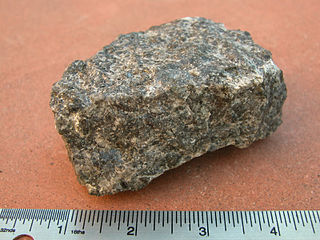
Gabbro is a phaneritic, mafic intrusive igneous rock formed from the slow cooling magma into a holocrystalline mass deep beneath the Earth's surface. Slow-cooling, coarse-grained gabbro is chemically equivalent to rapid-cooling, fine-grained basalt. Much of the Earth's oceanic crust is made of gabbro, formed at mid-ocean ridges. Gabbro is also found as plutons associated with continental volcanism. Due to its variant nature, the term gabbro may be applied loosely to a wide range of intrusive rocks, many of which are merely "gabbroic". By rough analogy, gabbro is to basalt as granite is to rhyolite.

Feldspar is a group of rock-forming aluminium tectosilicate minerals, also containing other cations such as sodium, calcium, potassium, or barium. The most common members of the feldspar group are the plagioclase (sodium-calcium) feldspars and the alkali (potassium-sodium) feldspars. Feldspars make up about 60% of the Earth's crust and 41% of the Earth's continental crust by weight.
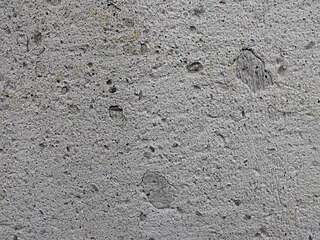
Trachyte is an extrusive igneous rock composed mostly of alkali feldspar. It is usually light-colored and aphanitic (fine-grained), with minor amounts of mafic minerals, and is formed by the rapid cooling of lava enriched with silica and alkali metals. It is the volcanic equivalent of syenite.

Basanite is an igneous, volcanic (extrusive) rock with aphanitic to porphyritic texture. It is composed mostly of feldspathoids, pyroxenes, olivine, and calcic plagioclase and forms from magma low in silica and enriched in alkali metal oxides that solidifies rapidly close to the Earth's surface.

Tonalite is an igneous, plutonic (intrusive) rock, of felsic composition, with phaneritic (coarse-grained) texture. Feldspar is present as plagioclase (typically oligoclase or andesine) with alkali feldspar making up less than 10% of the total feldspar content. Quartz (SiO2) is present as more than 20% of the total quartz-alkali feldspar-plagioclase-feldspathoid (QAPF) content of the rock. Amphiboles and biotite are common in lesser quantities, while accessory minerals include apatite, magnetite and zircon.
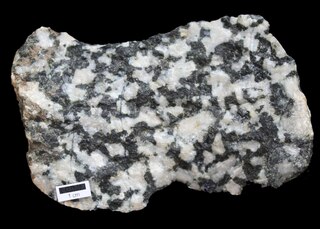
Diorite is an intrusive igneous rock formed by the slow cooling underground of magma that has a moderate content of silica and a relatively low content of alkali metals. It is intermediate in composition between low-silica (mafic) gabbro and high-silica (felsic) granite.

The lithology of a rock unit is a description of its physical characteristics visible at outcrop, in hand or core samples, or with low magnification microscopy. Physical characteristics include colour, texture, grain size, and composition. Lithology may refer to either a detailed description of these characteristics, or a summary of the gross physical character of a rock. Examples of lithologies in the second sense include sandstone, slate, basalt, or limestone.

Intrusive rock is formed when magma penetrates existing rock, crystallizes, and solidifies underground to form intrusions, such as batholiths, dikes, sills, laccoliths, and volcanic necks.
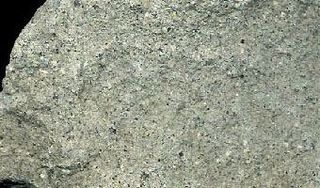
Rhyodacite is a volcanic rock intermediate in composition between dacite and rhyolite. It is the extrusive equivalent of those plutonic rocks that are intermediate in composition between monzogranite and granodiorite. Rhyodacites form from rapid cooling of lava relatively rich in silica and low in alkali metal oxides.

A QAPF diagram is a doubled-triangle plot diagram used to classify intrusive igneous rocks based on their mineralogy. The acronym QAPF stands for "Quartz, Alkali feldspar, Plagioclase, Feldspathoid (Foid)", which are the four mineral groups used for classification in a QAPF diagram. The percentages (ratios) of the Q, A, P and F groups are normalized, i.e., recalculated so that their sum is 100%.
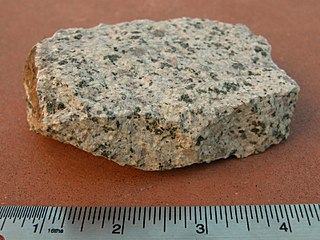
Monzonite is an igneous intrusive rock, formed by slow cooling of underground magma that has a moderate silica content and is enriched in alkali metal oxides. Monzonite is composed mostly of plagioclase and alkali feldspar.
Hawaiite is an olivine basalt with a composition between alkali basalt and mugearite. It was first used as a name for some lavas found on the island of Hawaii.

Trachybasalt is a volcanic rock with a composition between trachyte and basalt. It resembles basalt but has a high content of alkali metal oxides. Minerals in trachybasalt include alkali feldspar, calcic plagioclase, olivine, clinopyroxene and likely very small amounts of leucite or analcime.
Monzogabbro is an intrusive rock with a composition intermediate between gabbro and monzonite. It is defined in the QAPF classification as coarse-grained igneous rock in which quartz makes up 0% to 5% of the QAPF mineral fraction, plagioclase makes up 65% to 90% of the total feldspar content, and the plagioclase is calcium-rich.
Quartz gabbro is an intrusive rock with a composition intermediate between gabbro and tonalite. It is defined in the QAPF classification as coarse-grained igneous rock in which quartz makes up 5% to 20% of the QAPF mineral fraction, plagioclase makes up 90% or more of the total feldspar content, and the plagioclase is calcium-rich.
Nepheline-bearing gabbro is an intrusive rock with a composition intermediate between gabbro and nepheline gabbro. It is defined in the QAPF classification as coarse-grained igneous rock in which feldspathoids makes up 0% to 10% of the QAPF mineral fraction and are predominantly nepheline; plagioclase makes up 90% or more of the total feldspar content; and the plagioclase is calcium-rich.
Hornblende gabbro is an intrusive rock similar to normal gabbro. In the QAPF classification it falls within the gabbro field, in which quartz makes up 0% to 5% of the QAPF mineral fraction, plagioclase makes up 90% or more of the total feldspar content, and the plagioclase is calcium-rich. Hornblende gabbro is distinguished from other subtypes of gabbro by having a composition almost entirely of plagioclase and hornblende, with olivine and pyroxene each making up less than 5% of its mineral content.
Quartz monzogabbro is an intrusive rock intermediate between quartz gabbro and quartz monzonite. Under the QAPF classification, it is an intrusive rock in which quartz makes up 5% to 20% of the QAPF mineral fraction, plagioclase makes up 65% to 90% of the total feldspar content, and the plagioclase is calcium-rich.
Monzodiorite is an intrusive rock with a composition intermediate between diorite and monzonite. It is defined in the QAPF classification as coarse-grained igneous rock in which quartz makes up 0% to 5% of the QAPF mineral fraction, plagioclase makes up 65% to 90% of the total feldspar content, and the plagioclase is sodium-rich.
References
- ↑ Le Bas, M. J.; Streckeisen, A. L. (1991). "The IUGS systematics of igneous rocks". Journal of the Geological Society. 148 (5): 825–833. Bibcode:1991JGSoc.148..825L. CiteSeerX 10.1.1.692.4446 . doi:10.1144/gsjgs.148.5.0825. S2CID 28548230.
- ↑ "Rock Classification Scheme - Vol 1 - Igneous" (PDF). British Geological Survey: Rock Classification Scheme. 1: 1–52. 1999.
- ↑ Philpotts, Anthony R.; Ague, Jay J. (2009). Principles of igneous and metamorphic petrology (2nd ed.). Cambridge, UK: Cambridge University Press. pp. 139–143. ISBN 978-0-521-88006-0.